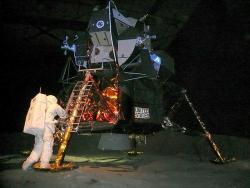In the early 1970s, American chemist Paul C. Lauterbur demonstrated that nuclear magnetic resonance (NMR) could be used to generate images of macroscopic objects. In the years following, magnetic resonance imaging (MRI) has been refined as a technique for the detailed resolution of internal structures. Lauterbur’s invention thus created a powerful diagnostic tool for the non-invasive examination of body tissues such as the brain, heart, and muscles. It allows for the early detection of cancer and other diseases.
1970-1979

YearAdded:
Image Credit:
Original Image: Courtesy of Flickr/Everyone's Idle (CC BY-SA 2.0)
Image Caption:
NMR and MRI: Applications in Chemistry and Medicine
Era_date_from:
1970s
2011

Cotton was once transported from farms to gins by wagons, trucks or trailers. Long waits to unload at the gin stalled harvests until haulers could return to the fields.
Professor Lambert Wilkes of the Department of Agricultural Engineering, Texas A&M University, developed the Cotton Module Builder between 1971 and 1974 with the support of J.K. (Farmer) Jones of Cotton Incorporated. The modules created by the Cotton Module Builder withstood weather, and after transport, the cotton could be easily fed into the gin. Dr.
YearAdded:
Image Credit:
Photo by Beaver (Thomas John Macartney)
Image Caption:
The cotton module builder revolutionized the cotton industry.
Era_date_from:
1971
2002

The Apollo lunar module (LM-13) was developed by the Grumman Aircraft Engineering Corp. (now Northrop Grumman). The LM's main functions were to carry two astronauts from lunar orbit to the moon's surface, and then return them to lunar orbit to rendezvous and dock with the Apollo command-service modules. On the surface, the LM served as a shelter and base of operations as the astronauts carried out their exploration and experiments. On July 20, 1969, the LM "Eagle" touched down on the moon, becoming the first piloted spacecraft to land on a celestial body other than Earth.
YearAdded:
Image Credit:
Courtesy Flickr/Michael Gray (CC BY-SA 2.0)
Image Caption:
The Apollo Lunar Module LM-13 on display in the Cradle of Aviation Museum
Era_date_from:
1972
2002

This is the first extremely smooth, surgically implantable, seam-free pulsatile blood pump to receive widespread clinical use. In its use in more than 250 patients, it has been responsible for saving numerous lives. When used as a bridge to transplant, the pump has a success rate greater than 90 percent. There has never been a device-failure-related fatality of any of these patients. A successful heart-assist pump could save an estimated fifteen thousand individuals annually.
YearAdded:
Image Credit:
Courtesy Wikipedia/Madhero88 (CC BY-SA 3.0)
Image Caption:
Pierce-Donachy Ventricular Assist Device
Era_date_from:
1973
1990

The Hughes Glomar Explorer was designed to complete the mission of lifting a 2,000-ton Soviet submarine 17,000 feet from the bottom of the Pacific Ocean. The Soviet Golf-II class submarine K-129 sank in the Pacific Ocean near Hawaii in April 1968 and the recovery mission, the “Jennifer Project”, as it was termed, took place in July 1974.
YearAdded:
Image Credit:
Courtesy ASME
Image Caption:
Hughes Glomar Explorer
Era_date_from:
1974
2006
Winter 2011 | Volume 25, Issue 4
The Glomar Explorer is an ASME landmark
“If you go back there it would mean war.” Those words, spoken by a Soviet naval officer, demonstrated the concern of Soviet officials as they learned that the Central Intelligence Agency had salvaged part—and possibly all—of a Soviet ballistic missile…
By:
Fall 1985 | Volume 1, Issue 2
Normally night spreads from east to west with the rotation of the earth, but the evening of November 9, 1965, was different. Darkness also spread from north to south. Southern Ontario went dark first, much of New York State a few seconds later, then most of New England, and finally New York City.…


